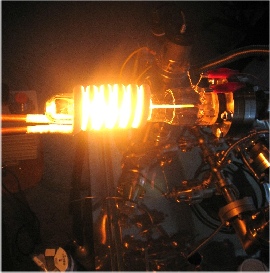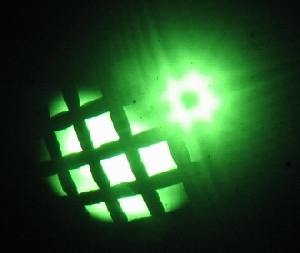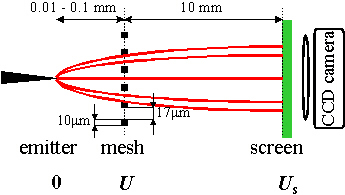The Vacuum laboratory has a long tradition in vacuum opto-electronics. The activities started in the fifties of the last century by R&D work on image intensifier tubes used for night vision systems. More on history
Professional electron tubes usually represent the state-of-the-art products which can only be developed by detailed knowledge of processes that influence their performances. Vacuum science and technology is the common interdisciplinary field that covers: material science, vacuum measurements and various sealing techniques, which all enable achieving stable high vacuum within sealed small systems. The topic is involved in the national program: "Vacuum technology and electronic materials" funded by the Slovenian Research Agency ARRS. Our experience with design and processing of electro-optical systems that guaranteed long-term operation of cathodes is explored today in two areas:
Study of hydrogen interactions with metals at low pressure. They include thermally excited and ionized molecule interactions with metal surfaces at pressures below 1 mbar. The topic is relevant in various fields ranging from basic to applied sciences. Measurements at elevated temperature near the detection limit of present-day pressure gauges not applying ionization, represent the exclusive tool to investigate kinetics of hydrogen interactions with metals.

Metal sample during RF thermal extraction in quartz thimble. The sample is in UHV as the RF heating begins. The kinetics of released gases can be determined upon the pressure rise curve and subsequent gas analysis with quadrupole mass analyzer.
Measurements are applied in combination with highly sensitive quadrupole mass spectrometry. It is well known that most of conventional surface sensitive analytical methods are blind for hydrogen while expensive nuclear methods which are suitable for hydrogen tracing, (NRA, ERDA, ?? ) are not very sensitive. Very sensitive methods applied for tritium have limited use in only a few labs word-wide. The Vacuum laboratory is involved in studies of deuterium interaction with materials relevant to the joint international research and development project (ITER) with two projects within the 6th framework. It is associated into the Center of Excellence Modern metal materials.
Study of electron field emission properties of novel nanostructured materials. . The motivation was triggered by novel inorganic nanotubes and nanostructured films first synthesised at the "Jozef Stefan" Institute. General interest for the research of electron field emission from nano-structured materials could be defined simply by: "obtaining a high value of field emission (FE) current at a moderate electric field, being stable enough for applications in various vacuum opto-electronic devices". There are two main areas relating field emission and nanoelectronics. The first area is to realize a point-like electron source which is a key element for electron guns being able to generate a few nm diameter wide electron beam with the anode at only a few kV. The second field is Flat Broad Area Field Emission Cathodes (FBAFEC) having some specific advantages compared to thermionic cathodes: electrons are emitted at room temperature, their energy spectrum is narrow. A potential application of FBAFEC is great, ranging from ultra-fast electronic circuits, x-ray tubes to flat electronic displays.


Field emission pattern from point source (left) and the principle of image formation (right)The specific advantage of techniques developed in the lab is visualization of the emitting site pattern, realized by spreading the electron paths emerging from a point source onto a distant luminescent screen, deposited inside a glass envelope of the field emission microscope (FEM). Besides the emitting pattern, the electron field emission current-voltage relation of the emitting tip could be also determined. More...
The lab cooperates with a few groups worldwide and is open for further cooperation. It is involved in two EU projects: NanoSafe and Foremost and is associated in the Center of Excellence Nanoscience and Nanotechnology.
